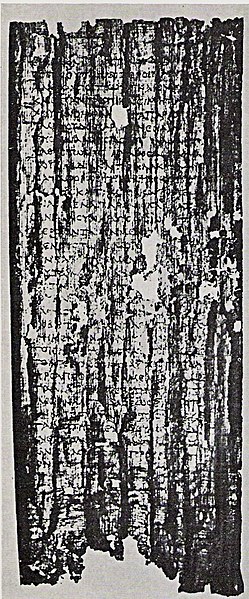In writing history from the early modern period onward, it’s a common problem to have too many sources for a given event so that it’s the job of the historian to (carefully, one hopes) select the ones that hew closer to the objective truth. In ancient history, on the other hand, we have so few sources to rely upon that it’s a luxury to have multiple accounts of a given event from which to choose:

Unrolled papyrus scroll recovered from the Villa of the Papyri.
Picture published in a pamphlet called “Herculaneum and the Villa of the Papyri” by Amedeo Maiuri in 1974. (Wikimedia Commons)
We used to play this game in graduate school: find one, lose one. Find one referred to finding a lost ancient text, something that we know existed at one time because other ancient sources talk about it, but which has been lost to the ages. What if someone was digging somewhere in Egypt and found an ancient Greco-Roman trash dump with a complete copy of a precious text – which one would we wish into survival? Lose one referred to some ancient text we have, but we would give up in some Faustian bargain to resurrect the former text from the dead. Of course there is a bit of the butterfly effect; that’s what made it fun. As budding classicists, we grew up in an academic world where we didn’t have A, but did have B. How different would classical scholarship be if that switched? If we had had A all along, but never had B? For me, the text I always chose to find was a little-known pamphlet circulated in the late fourth century by a deposed Spartan king named Pausanias. It’s one of the few texts about Sparta written by a Spartan while Sparta was still hegemonic. I always lost the Gospel of Matthew. It’s basically a copy of Mark, right down to the grammar and syntax. Do we really need two?
What would you choose? Consider that Homer’s Iliad and Odyssey are only two of the poems that make up the eight-part Epic Cycle. Or that Aristotle wrote a lost treatise on comedy, not to mention his own Socratic dialogues that Cicero described as a “river of gold”. Or that only eight of Aeschylus’s estimated 70 plays survive. Even the Hebrew Old Testament refers to 20 ancient texts that no longer exist. There are literally lost texts that, if we had them, would in all likelihood have made it into the biblical canon.
The problem is more complex than the fact that many texts were lost to the annals of history. Most people just see the most recent translation of the Iliad or works of Cicero on the shelf at a bookstore, and assume that these texts have been handed down in a fairly predictable way generation after generation: scribes faithfully made copies from ancient Greece through the Middle Ages and eventually, with the advent of the printing press, reliable versions of these texts were made available in the vernacular of the time and place to everyone who wanted them. Onward and upward goes the intellectual arc of history! That’s what I thought, too.
But the fact is, many of even the most famous works we have from antiquity have a long and complicated history. Almost no text is decoded easily; the process of bringing readable translations of ancient texts into the hands of modern readers requires the cooperation of scholars across numerous disciplines. This means hours of hard work by those who find the texts, those who preserve the texts, and those who translate them, to name a few. Even with this commitment, many texts were lost – the usual estimate is 99 percent – so we have no copies of most of the works from antiquity.1 Despite this sobering statistic, every once in a while, something new is discovered. That promise, that some prominent text from the ancient world might be just under the next sand dune, is what has preserved scholars’ passion to keep searching in the hope of finding new sources that solve mysteries of the past.
And scholars’ suffering paid off! Consider the Villa of the Papyri, where in the eighteenth century hundreds, if not thousands, of scrolls were discovered carbonized in the wreckage of the Mount Vesuvius eruption (79 AD), in a town called Herculaneum near Pompeii. For over a century, scholars have hoped that future science might help them read these scrolls. Just in the last few months – through advances in computer imaging and digital unwrapping – we have read the first lines. This was due, in large part, to the hard work of Dr. Brent Seales, the support of the Vesuvius Challenge, and scholars who answered the call. We are now poised to read thousands of new ancient texts over the coming years.
[…]
Now let’s look at a text with a very different history, the Hellenica Oxyrhynchia. The Hellenica Oxyrhynchia is the name given to a group of papyrus fragments found in 1906 at the ancient city of Oxyrhynchus, modern Al-Bahnasa, Egypt (about a third of the way down the Nile from Cairo to the Aswan Dam). These fragments were found in an ancient trash heap. They cover Greek political and military history from the closing years of the Peloponnesian War into the middle of the fourth century BC. In his Hellenica, Xenophon covers the exact same time frame and many of the same events.2 Both accounts pick up where Thucydides, the leading historian of the Peloponnesian War (fought between Athens and Sparta in the fifth century BC), leaves off.
While no author has been identified for the Hellenica Oxyrhynchia, the grammar and style date the text to the era of the events it describes. This is a recovered text, meaning it was completely lost to history and only discovered in the early twentieth century. Here, the word discovered is appropriately used, as this was not a text that was renowned in ancient times. No ancient historians reference it, and it did not seem to have a lasting impact in its day. What is dismissible in the past is forgotten in the present. The text is written in Attic Greek. This implies that whoever wrote the Hellenica Oxyrhynchia must have been an elite familiar enough with the popular Attic style to replicate it, and likely intended for the history to equal those of Thucydides and Xenophon. There were other styles available to use at the time but Attic Greek was the style of both the aforementioned historians, as well as the writing style of the elite originating in Athens. Any history not written in Attic would have been seen as inferior. Given that the Hellenica Oxyrhynchia was lost for thousands of years, it would seem our author failed in his endeavor to mirror the great historians of classical Greece.
The Hellenica Oxyrhynchia serves as a reminder that the modern discovery of ancient texts continues. Many times, these are additional copies of texts we already have. This is not to say these copies are not important. Such was the case of the aforementioned Codex Siniaticus, discovered by biblical scholar Konstantin von Tischendorf in a trash basket, waiting to be burned, in a monastery near Mount Sinai in Egypt in 1844. Upon closer examination, Tischendorf discovered this “trash” was in fact a nearly complete copy of the Christian Bible, containing the earliest complete New Testament we have. One major discrepancy is that the famous story of Jesus and the woman taken in adultery – from which the oft-quoted passage “let he who is without sin cast the first stone” originates – is not found in the Codex Sinaiticus.
Yet, sometimes something truly new to us, that no one has seen for thousands of years, is unearthed. In the case of the Hellenica Oxyrhynchia, no one seemingly had looked at this text for at least 1,500 years, maybe more. This demonstrates that there is always the possibility that buried in some ancient scrap heap in the desert might be a completely new text that, once published for wider scholarship, greatly increases our knowledge of the ancients.
How does this specific text increase our knowledge? Bear in mind that before this period of Greek history, we have just one historian per era. Herodotus is the only source we have for the Greco-Persian Wars (480–479), and the aforementioned Thucydides picks up from there and quickly covers the political climate before beginning his history proper with the advent of the Peloponnesian War in 431 BC. But Thucydides’s history is unfinished – one ancient biography claims he was murdered on his way back to Athens around 404 BC. Many doubt this, citing evidence that he lived into the early fourth century BC. Either way, his narrative ends abruptly. Xenophon picks it up from there, and later we get a more brief history of this period from Diodorus, who wrote much later, between 60 and 30 BC. While describing the same time frame and many of the same events, these two sources vary widely in their descriptions of certain events. In some cases, they make mutually exclusive claims. One historian must have got it wrong.
For centuries, Xenophon’s account was the preferred text. That is not to say Diodorus’s history was dismissed, but when the two accounts were in conflict, Xenophon’s testimony got the nod. This was partially because Xenophon actually lived during the times he wrote about, whereas Diodorus lived 200 years after these events in Greek history. Consider if there were two conflicting accounts of the Battle of Gettysburg from two different historians: one actually lived during and participated in the war, while the other was a twenty-first century scholar living 150 years after the events he describes. They disagree on key elements of the battle. Who do you believe? This was precisely the case with Xenophon and Diodorus. Yet, once the Hellenica Oxyrhynchia was published, it corroborated Diodorus’s history far more than that of Xenophon, forcing historians to reconsider their bias toward the older of the two accounts.
1. You can find a list of texts we know that we have lost at the Wikipedia page “Lost literary work“.
2. “Oxyrhynchus Historian”, in The Oxford Companion to Classical Literature, ed. MC Howatson (Oxford University Press, 2011).






